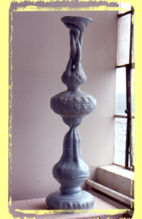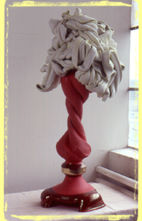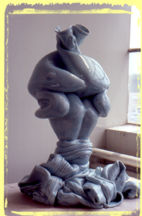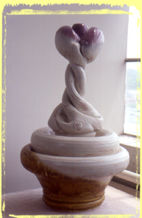



Catastasis/Vase Form #9


Catastasis/Vase Form #10
Forrest Snyder
Matthew Towers received his B.F.A. in Theater from New York University and his M.F.A. in Ceramics from The New York State College of Ceramics at Alfred University in 1996. Since 1997, He has been Assistant Professor of Ceramics at the Hartford Art School, University of Hartford. In the summer of 2000, Mr. Towers was an artist-in-residence at the Archie Bray Foundation. His work has been shown nationally and internationally in solo and group exhibitions. He has also lectured at universities around the United States. His work is in collections such as The Jingdezhen Museum of Ceramics (China), The Schein-Joseph International Museum of Ceramic Art, (NY), The Archie Bray Foundation (MT) and the Pfannebecker Collection (PA).
Recently, Critical Ceramics had the opportunity to speak with Mr. Towers in his Hartford, CT studio about his work, teaching, and the trials of being a contemporary artist.
Critical Ceramics: How did you get started?
Matt Towers: My first exposure to ceramics was in high school where there was a ceramics class. I used to walk by the door and peek in. It seemed exciting to me. Eventually, I taught myself to throw. At the same time, I started getting interested in theater; I ended up going to NYU as a theater major. After graduating from NYU, I worked assorted jobs so I would be able to pursue my acting career. Gradually acting fell by the wayside and I became lost creatively. Many years went by until I rediscovered ceramics.
I took an adult education course with Bruce Winn at Parsons. Then, within a short time, Bruce got me an assistant job to Betty Woodman.Talking to Betty and Bruce, I decided to quit my job, move out of New York City,and go back to school. I enrolled at Alfred as an undergraduate. Two years later, I applied to the Alfred graduate program.
CC: You obviously had a natural love for the material and process, but everyone doesn’t turn their life upside down to follow a calling...
MT: Ha! At the beginning, I thought ceramics only meant craft fairs - we only had one book on ceramics in my high school library and our teacher never told us all the possibilities there were with clay. I skipped my high school graduation to go with a friend to the Northeast Craft Fair. So, that we could see “what the ceramic world was all about.” We didn’t like much of what we saw. I thought, “this isn't what I want to do” and I didn’t return to ceramics for 13 years.
CC: Early on, you made functional pots?
MT: Well, I made pots, but even the closest thing I got towards function was never ergonomically correct or utilitarian. I was always concerned with gesture, exaggerated form and things that could happen with the material... pots were just a format to express those ideas, the utilitarian concerns were last on my list.
CC: Do you recall a point where being a potter, an artist, became a career vision?
MT: Actually, when I took that first adult ed class, I was thinking about that — I knew I was going to make a serious life changing decision. But my thoughts were more along the lines of industrial design of pottery. I didn’t know anything about being a studio artist until later. Bruce Winn showed me that world. He was the example of what I could be.
CC: How do you balance your days between studio artist and teacher?
MT: First of all, I think that any good educational program understands that part of being an art professor is having a career — making, showing, selling. You’re there, in part, as an example to the students of what a professional in the field should be doing.
On the days that I teach, my concentration is on my students and the days when I'm not teaching, my main concentration is on my studio. During the school year, I try to get four full days a week in the studio — the days that I'm teaching , I save smaller studio jobs that take a different kind of concentration than the making or glazing process. For making, I must have consecutive days; there’s something about the scale and kind of work that I’m doing now that demands that extended time.
CC: Can you just jump in on the first day and have that magical energy?
MT: That’s another reason [for having four consecutive days]. Sometimes the first day is a waste of time and sometimes it flows. It all depends on the other things that are going on. .
CC: Is there back-and-forth, give-and-take, between the studio and the teaching?
MT: Definitely. If I’m energized about my work, my teaching is much better. I feel so much more connected. I have that feeling of being in the middle of making work which is where students are all the time, hopefully. We share that trait of never having our work out of our minds during waking hours!
CC: How do you start?
MT: I have a pretty clear idea of what I want a piece to look like. But I’m certainly willing to let it go out of those boundaries, too. For example, here I have this sketch. The stand and vessel form are very similar from drawing to the finished ceramic object. Sometimes, I have an image of what one part will look like and then when it is made, I’ll know what the other part should be. In other respects, I have no leeway. My stand and piece must fit together exactly, so I have molds — a positive and negative — which I throw on so that they will fit. If I use the same molds on several pieces, they are, to some degree, potentially interchangeable.
CC: How did you develop this sophisticated way of throwing off of interlocking molds?
MT: This technique is really just a bastardization of ways of working that had already been done. My work is just a technical extension. The Romans threw into molds. Potters make things in parts. The wheel is my main tool. During and after throwing, I do a lot of manipulation of forms. In my mind, my surface decoration has to push into, become form. So, what begins as, say, decorative stamping, is now pushing so far into the clay that form is altered.
CC: What changes do you make as you go along?
MT: Working is a pretty intuitive process. I know when I don’t like something. Seeing an object in three dimensions can make all the difference.
There are certain realities. I have this kiln. This kiln is 31" deep. With some extra bricks, I can go up to 39" tall. That’s one part of a piece — either a stand or vase form. But I know that I can only get up to cone 04 using the bricks, not to cone 10. So, I can bisque here and then take the work to school [where there’s a bigger kiln]. If I don’t want to do that, then I scale up my drawing and figure out the exact heights of the parts for a total height of 31".
CC: What if you had a kiln five feet tall?
MT: I’d love to make work that tall. Certain ones, I want to be a specific size. Sometimes bigger is better.
CC: What about the horizontal dimension?
MT: I’m maxed out there, too. I fudge it. I hang some of the stands over the shelf. I am very concerned with length and width. Right now I’m more into width. It’s harder to achieve than length.
CC: Why do you call the bottom parts of your pieces �stands�?
MT: That’s my own language for different parts of the piece. Really the top part is a vessel and it’s made in a way that a stand is required. I like to imagine that this ornate thing is an abstracted hairstyle. A wig on a stand, if you will. It’s like the women in the court of Louis XIV putting a bird on top of their hairdo.
CC: You have thought at times much more literally. Is the level of abstraction a matter of comfort?
MT: At times, I may have been thinking more literally, I don’t know that the work was any more literal. What I think privately while I’m making is for my own motivation. I love hiding the literal in the abstract. A lot of the very literal stuff bombs. You’ve got this thing in your head. You’ve got to see it in front of you to know that it’s dead!
Much of the time, when I play around in the studio making these things, they start to make me laugh; that's when I know it's probably a good idea. I find the material itself can be sensual. But I want the work to be about many things. I do like the historical ceramic references. I do like the fact that they are vessels.
I don’t actually borrow from any one source directly. I get excited by architecture, interior design, and industrial design. NEST is my favorite magazine. Aside from the amazing design of the magazine itself, I love the way they'll have an article about the interior decorating aesthetics of the people who squat in the underground tombs in Egypt right next to an article about some fabulous palace in Morocco or on the Long Island Shore. I hope that my work has a similar sense, form, style, decoration, and humor being thrown together in a good way.
I don’t think for a second that most people find my work beautiful, but I do. Beauty has many layers. To make something beautiful is one of the hardest things in the world. I don’t think my work represents the usual, understood, aesthetics of the day.
CC: Why not work on accessibility?
MT: Because I can’t. I can get a lot of satisfaction making accessible objects for a short period of time. But it’s the harder, less accessible, less obviously beautiful perhaps, that saps all of my energy in the best possible way. I can’t not do it. I believe in it. I mean, I could make a fairly decent pot that many more people would like right off the bat, but that’s not me. I have something to say, something new to do with the vessel. My hope is that if I keep doing it, then enough people will eventually get it.
CC: And then what?
MT: The next step. Anyone who is worth their salt is always tweaking things. Questioning. When you’re in it, the most minute details become huge issues.
CC: To help address these concerns, do you work in series?
MT: I have times when I’m working on the same theme in several pieces, or I’ll be working on one piece and see something that excites me, so I’ll try several more pieces playing with that aspect I’ve just realized. In the end, I’d like to arrive at multiple answers to each question.
CC: Are you asking, that is making, the best questions, the best work, you’ve ever done?
MT: Yep. I think I’ve become deluded in my own studio... (laughs). But for me, right now is the most excited I’ve been. The scale is a new thing for me. And I want to keep playing with that. I had been putting my work on regular pedestals, but now I’m thinking I really want to have something to look up at; in some of the pieces the important details are under the rim. The next thing for me to play with is what you would think of as a pedestal, my stands, but really it will be part of the form.
CC: What’s the best pot you’ve ever made?
MT: The one I’ve just made. It’s always the one I’ve just made because no matter how good or bad it is, the next one will be better still.
CC: Who do you think are some of your under rated contemporaries?
MT: I'm not sure if under rated is the right description — more like under recognized. Paul McMullen is not getting the attention he deserves. Paul is doing things with imagery and sculpture that nobody else is doing. Denise Pelletier. Andy Braman is an amazing potter. Casey O’Conner. Mary Louise Carter. Many more. Many of my contemporaries get recognition here and there, but never enough.
CC: Finally, what is it about Ceramic artists that’s preventing them from finding equality in the art world?
MT: It’s God’s will.

Catastasis/Vase Form #7


Catastasis/Vase Form #8